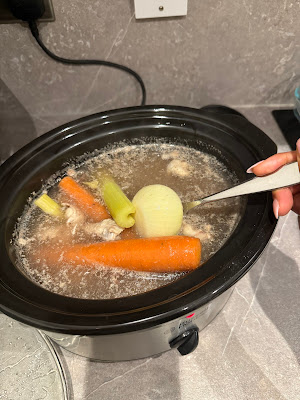Since changing my diet to a more holistic approach, I have been making my own chicken bone broth at home. It has been the best broth to add to stews and soups. I even drink it first thing in the morning on an empty stomach as it has a lot of health benefits. It's full of flavour and has anti-inflammatory properties. I follow this recipe from the book |"The 4-Week Endometriosis Diet Plan", but I tweaked it to my preference.
These are the benefits of having bone broth;
- Improved joint health: The collagen in bone broth can help improve joint pain and stiffness
- Better skin health: The collagen in bone broth can help improve skin elasticity and health.
- Improved gut health: The collagen in bone broth can help heal the gut lining and reduce inflammation.
- Improved immune system: The minerals in bone broth can help support the immune system.
- Improved digestion: The nutrients in bone broth can help stimulate digestive juices and soothe gut inflammation
- Improved brain function: The glycine in bone broth can help detoxify cells from chemicals and improve brain function
- Improved sleep: Bone broth may help support healthy sleep. (source - Google)
recipe for bone broth
2 carrots, barely chopped
1 onion, barely chopped
Filtered water
sea salt
apple cider vinegar
How to Store Your Bone Broth
Once your bone broth is finished cooking and cooled down, it’s important to store it properly to preserve its flavour and nutrients.
Cool it Quickly: To avoid any bacterial growth, let the broth cool down to room temperature before storing it. You can speed up this process by placing the pot in a sink with ice water (just make sure the broth doesn’t touch the water). This will ensure the broth stays safe for longer periods.
Use Glass Containers: For the best long-term storage, use glass jars or airtight containers. Glass helps to preserve the flavour and quality of the broth, and it’s also easy to clean. If you plan to use it within a few days, smaller jars or containers can be ideal for easier access.
Freezing: If you’ve made a large batch, you can freeze bone broth for up to 3 months. For convenient portion sizes, pour the broth into ice cube trays or silicone moulds before freezing. Once frozen, transfer the cubes into a freezer-safe bag or container so you can easily grab just the right amount whenever you need it.
Refrigeration: In the fridge, bone broth can last up to 5 days. Store it in an airtight container, and make sure to consume it within that time frame. If you won’t be using it up within the week, freezing it is your best bet.
Skim the Fat: When storing in the fridge, you’ll notice that the fat in the broth will solidify at the top. If you prefer a leaner broth, simply skim the fat off before storing it or before using it in recipes. The fat can also be saved and used for cooking—it adds great flavour!
Reheat Carefully: When you’re ready to enjoy your broth, reheat it gently on the stove. Avoid boiling it, as this can alter the taste and consistency. If you’ve frozen it, allow it to thaw in the fridge overnight or heat it up directly from frozen by simmering on low heat.

No comments
Post a Comment